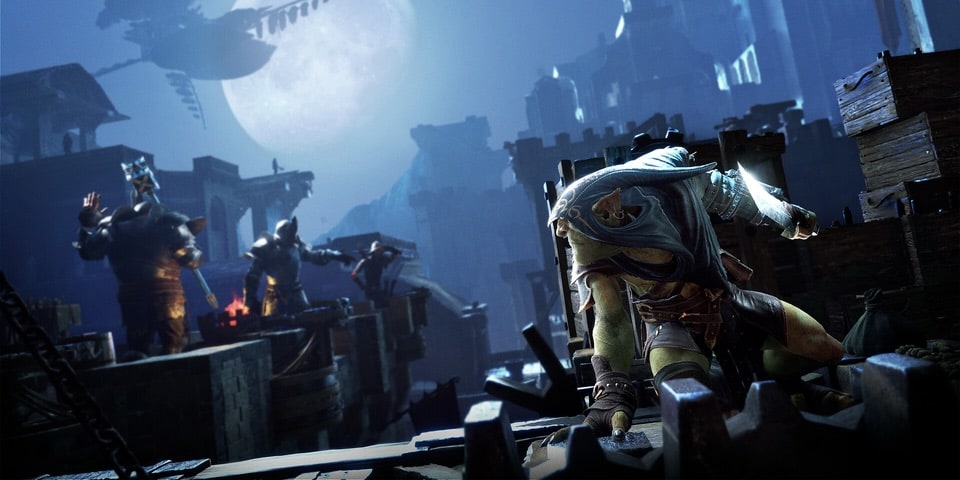Even in the ranks of nasty little goblins in fiction, Styx is a particularly mean little fellow, but then what would you expect from the grim fantasy world that he was born into? With elves, humans and dwarves all various shades of mean, conniving, and genocidal, it’s not like Styx is morally inferior to those he’s going up against. But now, in Styx: Blades of Greed, he’s not doing it alone.
Styx has often been able to rely on the help of others in his first two solo adventures, often in an ‘enemy of my enemy’ kind of way, but as Styx looks to escape from the lockdown in place on the human fortress of The Wall, he starts to put together a crew of rapscallions to join him, with a mix of new and returning faces. And what’s the latest object of Styx’s obsession? Well, it’s the power of the Quartz.
Our hands-on picked up right at the beginning of the game, with Styx needing to plot an escape, with a little advice from Helledryn to do so. The Wall is an imposing fortress, built up and up the side of a, well, a giant wall or cliff face, in a fashion that makes Helm’s Deep and Minas Tirith look vertically challenged. Structures sprout out and hang over the rocky abyss below with one of the main ways to get around being to catch a quick zeppelin. But who would ferry a sneaky little goblin around town? Well, maybe you can spring the ship of a drunkard dwarvish captain whose ship has been impounded by the Inquisition?
Yeah, that sounds like a pretty good plan, and lets you get a real feel for the early stages of this game’s stealth action, which is still as broad and flexible as before. Guards tend to go on nicely predictable patrol paths and react in a suitably game-like fashion to make this an enjoyable playground to sneak through, and should react in fairly expected ways to what you try to do. The direct approach is always possible, having Styx slink between cover, get the drop on enemies (often literally from above) and stashing bodies away in boxes as you go. Should you get spotted, you don’t stand much of a chance in one-on-one combat, so it’s best to stay in the shadows, use crawlspaces and more, as well as some extended techniques like poisoning drinking water by just gobbing in it, placing traps, triggering environmental hazards with a goblin clone, possessing guards, and more. If you’re spotted, they put up their hackles for a while, potentially making use of poison gas to try and flush you out of tunnels if they think you just ducked into one, and generally keeping you on your toes.
But Styx: Blades of Greed wouldn’t stop with just retreading the past. In trying to spring the zeppelin from being impounded, Styx needs to break through a Quartz lock, and as he gets some help to do so, he’s drawn to the immense power that this can provide. Also, it starts talking to him with the promise of even more power if he can find more Quartz. What could possibly go wrong here?
As Styx tracks down more shards of Quartz and absorbs their power, he’ll be able to unlock new time-twisting abilities and more that it enables, this coming as a separate skill tree to go alongside the standard Amber skills and crafting recipes he’s learnt. You won’t need the Quartz for some of his other new abilities, though, with a glider that lets you sail through the sky, a grappling hook and claws to climb up taller walls.
This all ties in with a much greater sense of verticality and discoverability through the game’s three environments. The Wall is the home of the humans, while Turquoise Dawn is the more verdant home of the Orcs, and the game will also return to Akenash, the now ruined site of the first title. Each of these regions are going to evolve and open up to you more and more as you unlock those core new movement abilities, so where the first two Styx titles were of a linear structure, Blades of Greed will be more of an evolving open world, replete with key fast travel hot air balloon wharfs.
It’s genuinely great to see Styx: Blades of Greed bringing the mouthy goblin assassin back for a new generation. The previous games had a scrappy upstart kind of charm to them, and that’s continuing through here, with Cyanide getting more ambitious in how they construct the game into a stealthy playground. Styx might never be a truly revolutionary series, but it’s still plenty of fun, and I’m looking forward to the game’s release later this year.







This preview of Styx: Blades of Greed sounds intriguing! It’s always interesting to see how unique characters like Styx are developed in games. Looking forward to seeing how the gameplay unfolds!
Absolutely! Styx’s character certainly adds a lot of depth to the game. I find it fascinating how the blend of stealth mechanics and humor can create such a unique gaming experience. It’ll be exciting to see how players navigate the challenges he presents!
I completely agree! Styx’s complexity really enhances the gameplay experience. It’s interesting how his mischievous nature influences not just the story, but also the player’s strategy when navigating through challenges.
you pointed that out! Styx’s moral ambiguity adds a unique layer to the narrative, making players question their own choices. It definitely keeps things engaging and thought-provoking throughout the game.
Absolutely, the moral ambiguity really does set Styx apart from typical characters. It challenges players to navigate their decisions carefully, which can lead to some intriguing gameplay moments. Plus, the intricate lore surrounding goblins adds depth to his character.
I completely agree! Styx’s complexity really adds depth to the story. It’s interesting how his actions force players to question their own morals, making the gameplay experience much more engaging.
Absolutely! Styx’s morally ambiguous nature makes him a fascinating character to follow. It’s intriguing how his actions often blur the lines between hero and villain, which keeps the players engaged and questioning their choices throughout the game.
I completely agree! Styx’s morally ambiguous nature really adds depth to the story. It’s interesting how his cunning and survival instincts often blur the lines between hero and villain, making every decision he faces feel tense and unpredictable.
Absolutely! His morally gray character really keeps players guessing about his motives. Plus, the dynamic between Styx and the other characters adds an extra layer of intrigue to the gameplay.